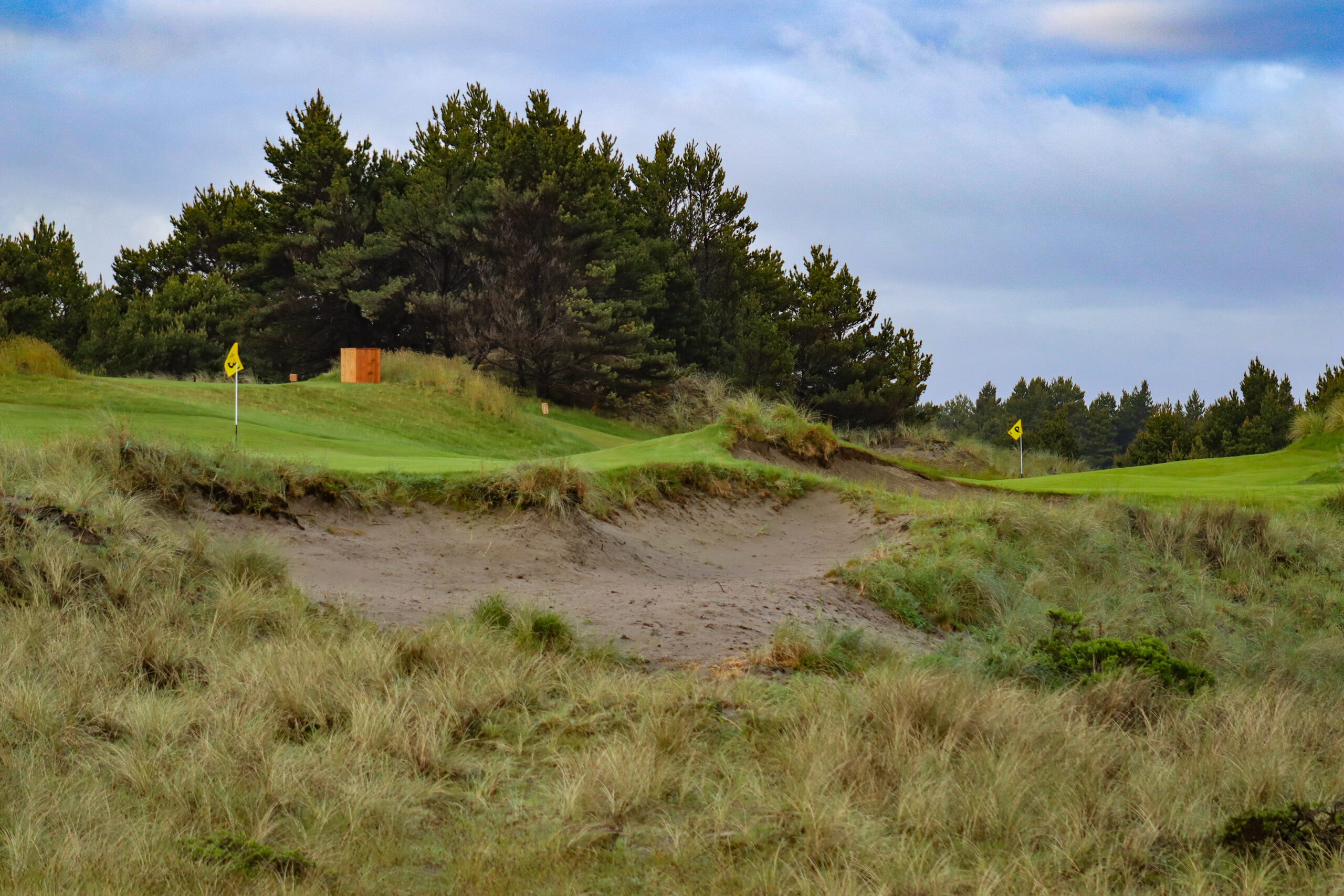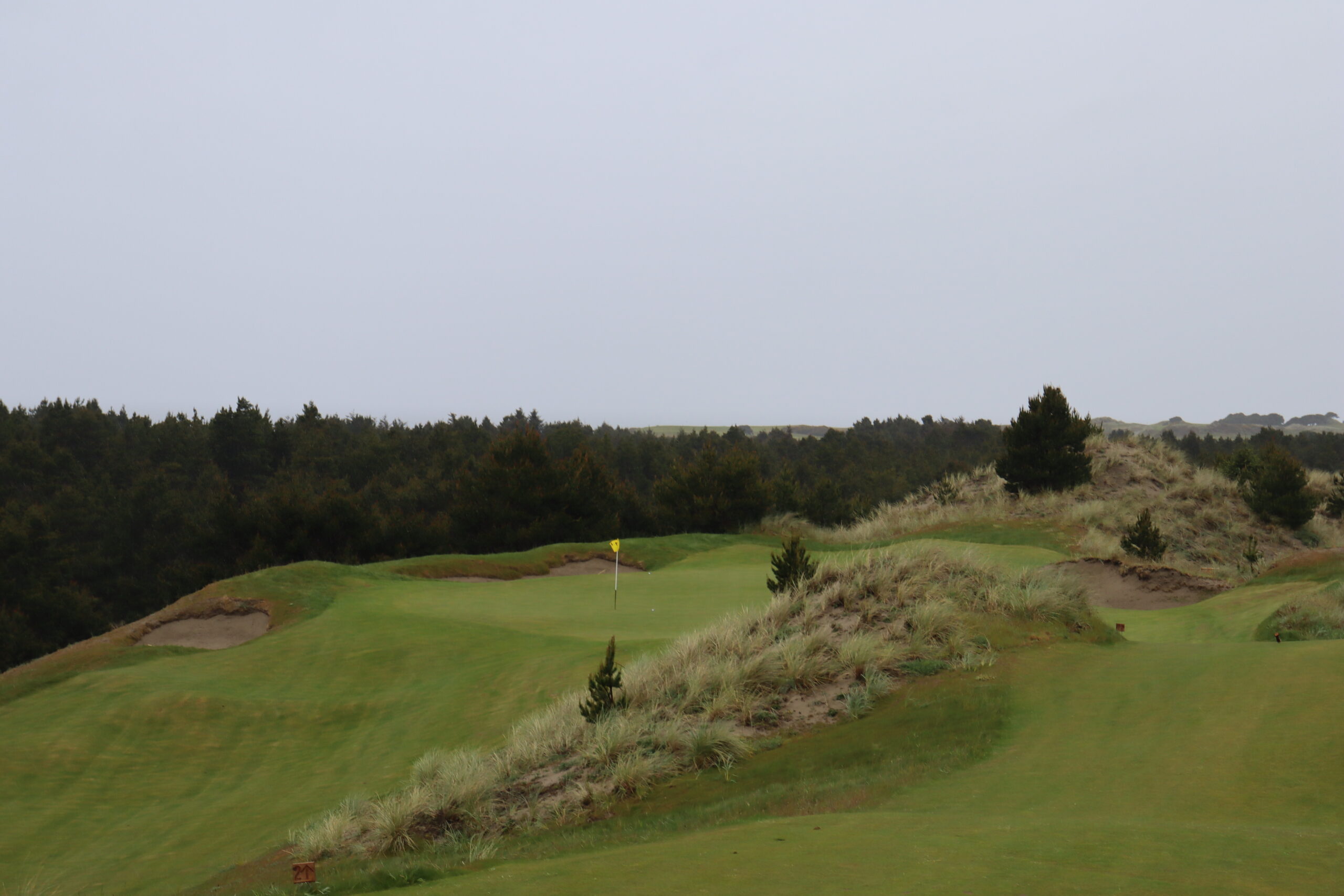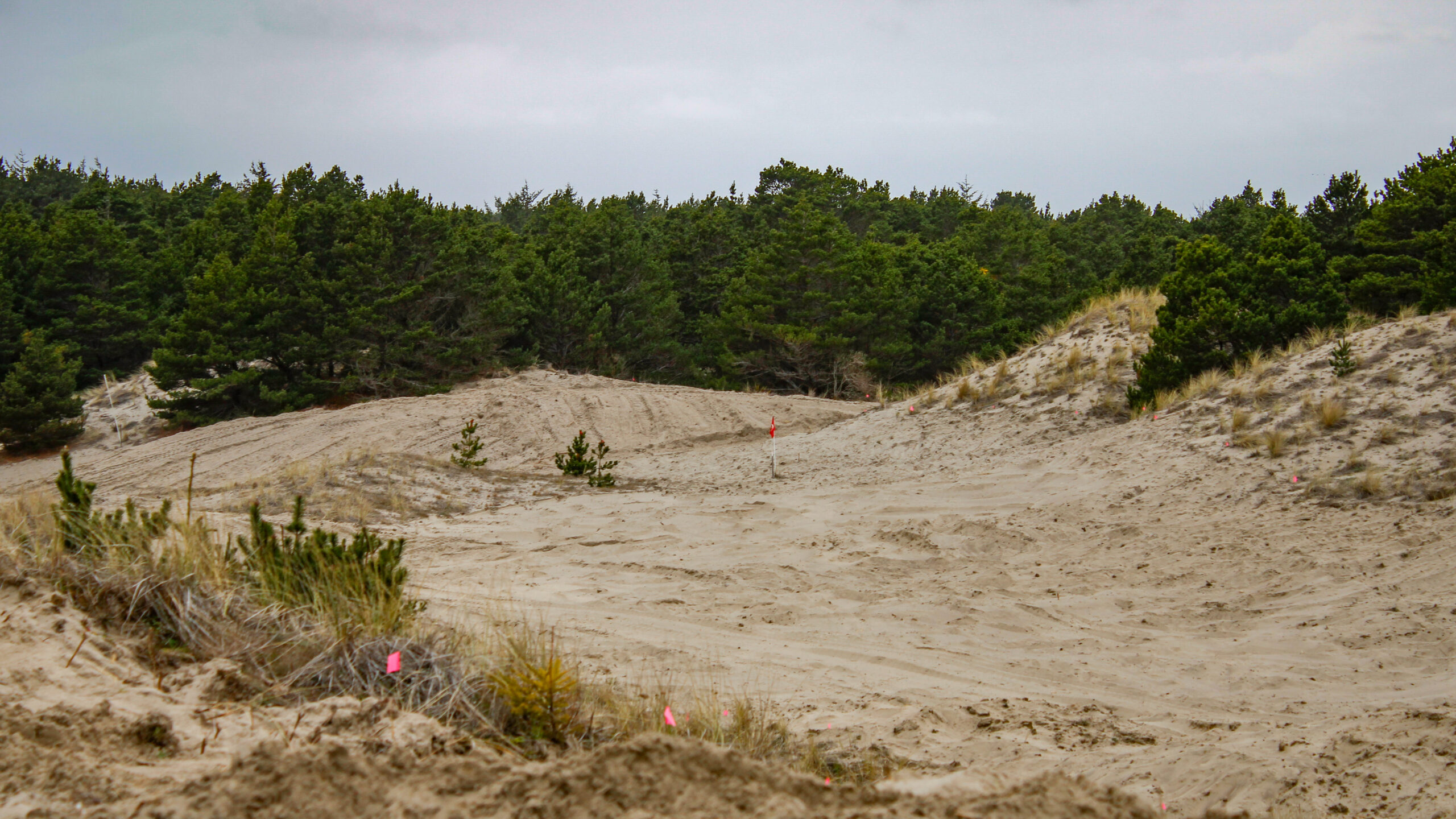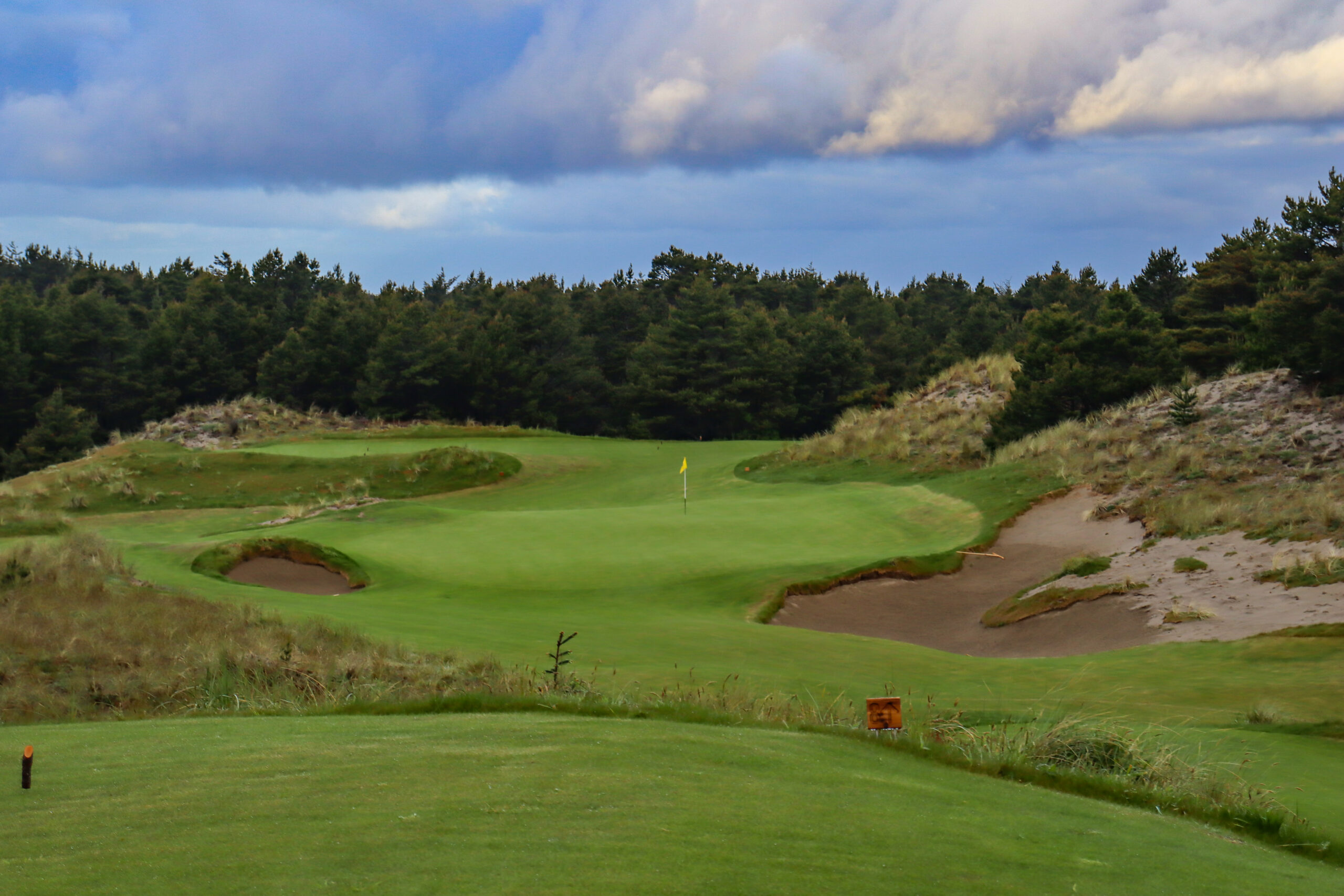Like so many other golf trips heading to Oregon to play the coastal mecca with designs from Bill Coore, Tom Doak, and David McLay Kidd at the famed Bandon Dunes Golf Resort, it begins at Portland International Airport (PDX) landing on a cloudy, slightly rainy day. Sure, you might be able to fly into North Bend closer to the resort in the summer through connecting routes in San Francisco or Denver, and perhaps you even try to fly to Eugene, but Portland is the major airport in the state of Oregon, and almost everyone I know who has gone on a golf trip here ends up flying to Portland for convenience. As expected, the weather in the Pacific Northwest is unpredictable for the trip: a bit of sun and everything else, with rain being a constant in this area, especially from, say, October 1-May 15. So, too, is the wind, especially at the coastal town of Bandon, Oregon draped over the seaside shores of the stunning Pacific Ocean, though that is a five-ish hour and one In-N-Out stop away in advance.
Checking the forecast, a “less-than-ideal” reality greets us, with the south wind dominating the trip. For regular Bandon visitors and locals, that wind direction indicates cooler, winter conditions, and in this case, rainy and wet expectations. The golf courses are built for both winds and any sort of weather conditions, yes—and that is, largely, credit to the architects of each golf course, who managed to make each hole work in each condition or wind direction—but the summer season is the “high” season for the resort, and each golf course seemingly benefits from the summer wind. Take Pacific Dunes as the example: the longer par 4’s come at the 4th (south), 7th (south), and 13th (north), favouring the wind coming from the north, while the par 5’s are seemingly made to play longer with the short 3rd and 12th heading northwest and north, respectively, and the long 18th heading south home. The par 3’s and the short and middle-length par 4’s balance out in a variety of directions. Suddenly, with the winter south wind, the difficulty of Pacific Dunes is elevated, with more long par 4’s into than not, and the longest hole on the golf course (18th) playing straight into the teeth of it.
Luckily, I have played each course at the resort numerous times, so a bit of rain and wind and some coolness never hurt anyone. I had my opinions on the courses, and a bit of weather would not damage that necessarily—for better or worse, I guess… I’m stubborn!—so I was there to enjoy the celebration of 25 years at this momentous resort in the world of golf. On the golf side, my priority was a full dissertation of Shorty’s, the newest golf course at the resort and the first design from the newly-established design firm of Rod Whitman, Dave Axland, and Keith Cutten, known as Whitman, Axland, and Cutten or WAC, for short. The crew have contributed to numerous designs either separate or together, though this is their first official golf course to open under their new firm.

Having spent a good chunk of two days walking around this property in March of 2023 getting into the routing and natural features before any golf was in the dirt, I was excited to see the property evolve from the sandy scrub and dunescape into a short-course playground. In fact, my walk around the 7th course at Bandon Dunes was so early that the name “Shorty’s” was not official, instead writing about “Bandon No. 7” as part of the “Early Thoughts” series.
I was explaining all this to my dad as I prepped him for his first time to Bandon Dunes, southbound on the Interstate-5 before heading to the coast on the windy, curvy roads through the Evergreens and eventually the sandy seaside dunes in Florence. Having been to the resort three times prior to this edition, I was familiar with the excitement building as we got closer and closer. On my first visit, a road trip from Arizona to British Columbia let me explore Highway 101 up the Oregon Coast, somewhat interrupted by the fact that Bill Coore and Mr. Keiser were exploring the original Tom Doak version of Sheep Ranch. I was supposed to play the 13-green Sheep Ranch before a random phone call from an Oregon number a few days before I was supposed to play told me I couldn’t be on property anymore, even if I had already sent in my cheque of $100 to a random PO box in the town. As a result, I ended up playing Pacific Dunes and Bandon Trails on a last minute booking—a good compromise, but I digress, having never experienced the OG Sheep Ranch as one of my biggest ‘close calls’ in my golfing life. The second time, another road trip from San Francisco, was me squeezing in a full three days of golf at the resort between California Golf Club of San Francisco and Lake Merced Golf Club on either side, fully indulging into the entire resort’s offerings. I played everything on that trip—Old Macdonald, Bandon Dunes, and Sheep Ranch for the first time, plus a maiden voyage around Preserve—and walked away with a burning desire to get back immediately. Finally, the third time at the resort, filled with golf at the usual offerings and exploring Charlotte’s when it was called Shorty’s and the current Shorty’s not even having a name yet. Each return visit meant another trip to golf’s greatest resort, and yet, each time, I felt like I wanted to return again as soon as I walked off the property. There is no such thing as “Bandon Fatigue.”

This trip, though, was a bit more exciting for a variety of reasons. For one, it was the 25th anniversary celebration of a resort that largely shifted the culture of everything we consider to be contemporary golf architecture and golf travel. Yes, we look at Sand Hills (1994) as the watershed moment for the minimalism movement, but I contend that without Bandon Dunes (1999) and especially Pacific Dunes (2001), steering into Mr. Keiser’s “one course is a curiosity, two is a destination” philosophy, the general public would not have been exposed to the movement, and it likely would not have caught on to the extent we experience golf architecture and the boom of destination golf in 2024. That is where Bandon Dunes comes into play, and its influence into that architectural philosophy and cultural shift in how we experience golf trips is a key byproduct of the resort’s success.
What isn’t under-appreciated, however, is its influence on other resorts. Dream Golf’s portfolio, now extending to Sand Valley in Wisconsin and the forthcoming Rodeo Dunes in Colorado, is an impressive spin-off series from the OG in Oregon (impressive referring to Sand Valley… jury is still out on Rodeo Dunes!). Ben Cowan-Dewar’s Cabot Collection, once part of Dream Golf, includes stops in Nova Scotia, Scotland, Saint Lucia, and Florida, with more coming in British Columbia and elsewhere, too. Oh, and don’t forget about Streamsong and Forest Dunes, which have surely capitalized off the increased interest in remote destinations filled with great golf.
Secondly, this visit to Bandon Dunes meant the reality than Rod Whitman is, in my opinion, finally getting the credit he deserves and gets to stand against the industry leaders so many insiders have claimed his talents rival. Having grown up playing junior golf events at Wolf Creek’s Old and Links courses (Whitman’s first solo effort in Ponoka, Alberta), before eventually realizing his genius at Sagebrush in British Columbia, and enjoying his brilliance at Blackhawk and Cabot Links, Shorty’s felt like the “coming out” party where the world gets to realize what his architecture is about. Same for Keith Cutten and Dave Axland as well, Whitman’s partners in this endeavour (among many other active designs the trio are cooking up, including The Tribute in Bend, Oregon, The Ranch in Stuart, Florida, and others). For those three, this is the major label debut EP… the one that will get radio plays and be seen by a wider variety of people.

Though the debut LP, so-to-speak and to keep the music metaphor alive, will come at a later date to the US market in either Oregon, Florida, or elsewhere, all the trappings of talent are prevalent throughout the layout.
I question whether or not the greens tucked into the hillside across the golf course would become repetitive in any way. I flew the drone in the morning before we began to walk, and judging a golf course off a 4K camera is not usually a recipe for success. Cutten assures me not, but I make the mistake of assuming that early in our routing. Early Thoughts From a Too-Early Visit to Bandon Dunes No. 7 (2023)
At Shorty’s, the layout is cut into some of the most dynamic land on the entire resort, though this meant it was likely too aggressive for anything more than par 3’s. There is a reoccurring theme of greens situated into the dunescape, as if they are sitting in the low portions of the property rather than up high on top of the dunes. That becomes evident with the opening hole’s surface tucked at the base of the large dune running to the right of the opening two holes of Bill Coore & Ben Crenshaw’s Bandon Trails, and all throughout this golf course as well. Nevertheless, this archetype never feels overdone or overplayed, and in truth, my assessment from 2023 seems a bit suspect looking back now [editor’s note: I did recant that statement later in the article]. Given the surface selections across the entire golf course and the choppy property, I suspect one of the biggest hurdles the trio had to overcome was making sure the green surrounds were varied and unique. Even on the opening six holes—which, for those who remember, are the additional holes (plus the 19th) that got the golf course from the originally planned twelve to nineteen)—feature a variety of looks. The opening hole (below) has the dune high on its left side, while the 2nd has a depression up the left seemingly falling off into the nearby forest separating Shorty’s from the Pacific Ocean. The 3rd is at the base of the big dune the 1st played against, backing the green and creating a stunning vista with the 19th perched above, while the 4th, 5th, and 6th all feature a variety of looks that never really blend together. Even when holes occupy the same elements—say, the 1st with the dune up the left and the 11th with the same dune up the right—the green surfaces are so wildly different that the holes do not feel like a mirror of each other, and the concepts presented are fresh across the entire layout.

- 119 yards
- 124 yards
- 85 yards
- 80 yards
- 117 yards
- 84 yards
- 114 yards
- 104 yards
- 72 yards
- 101 yards
- 148 yards
- 133 yards
- 152 yards
- 161 yards
- 51 yards
- 123 yards
- 80 yards
- 92 yards
- 57 yards


Realistically, most of the golf course is compact. The opening six holes loop in itself, bringing the golfer back near the parking lot for the 7th hole, which prior to the extension to 19 holes would have been the opening hole (and ending on the 18th immediately to the golfers left standing on 7 tee), while the 7th and 17th cross over, and likewise for the 9th and 13th. These moments provide a communal dynamic, as if you’re consistently seeing the same people, watching their shots, and potentially playing with or against them. At Bandon Preserve, the concept is utilized occasionally, but not to the same extent as Shorty’s, where the same groups interact with each other throughout the round on numerous occasions and stops.
Had it not been a downpour and the final tee time of the day, I would have loved to see this in action, but even on opening day as I walked around talking photos, the sense of community or key gathering points was very obvious. Who wouldn’t want to be on a sixteen-person golf trip, and you largely get to see everyone’s shots across the entire property? On the 11th, as a perfect example, the feeder slope off the dune on the right could produce fireworks for those spectating from the 12th tee, or the crossover from the 17th green to the 18th tee and the 7th green (below) to the 8th tee allows some stunning vistas to watch balls fly at the yellow flags sitting into the landscape effortlessly.

Perhaps the biggest compliment to Shorty’s is the pacing and the flow of the routing, which feels like it is building towards something. The opening holes are a charming introduction, but do feel like a warmup as they prep the golfer for “something.” Well, that “something” is in the middle of the golf course. After the double green 9th and charming 10th, the golfer rises over the dune to reveal the stunning 11th at the base of the 1st green at Bandon Trails, where the meat of the golf course resides. The golf course is only 3 yards short of 2000, but nearly 30% of that yardage is made up in just the next four holes (21% of the golf course).
The most compelling golf is found here, in my estimation, with the 13th’s heroic shot from down in the valley immediately followed by the Hail Mary 14th some of the best back-to-back swings on the entire seven-course property, perfectly rounded out by the severe greens at the 11th and 12th (severe for different reasons, too!). Oh, and the juxtposition of the dynamic uphill 14th, the longest hole on the course, immediately followed up by the shortest hole on the coursde at the 15th with its green falling off at all sides, is rather superb. A strong 7 or even a (gasp) 6 iron in the summer wind for the best of players from the back tee followed by a 51 yard flip wedge over broken ground… how fun!

That charming flip wedge is a peach, but it begins the cooldown after the brutish middle of the round. Not too many movies truly end on a high note unless there’s a sequel coming, and every classic album ebbs and flows to tell a story, ending on an outro or the classic “sun setting” song or scene. That is the 15th-19th, with its charming 16th hole being the standout at the base of a massive dune and the green complexes coming home being the highlight. Rather than Preserve’s downhill charming hole—where putter is mandatory, by the way—Shorty’s ends on an uphill hole with a ridge running perpindicular to the line of play. I Maybe the tradition makes it way south and people start to putt here? Either way, I wouldn’t be surprised to see a handful of walk-off aces… and what a better way to end or begin a golf trip.
Bandon Slopes — Green Circles, Blue Squares, and Black Diamonds
[…] a great name for the property would be Bandon Slopes given the severity of such a site—too choppy for a big golf course, for those curious—with Green Circle, Blue Square, and Black Diamond emblems on the flags to represent which holes they are on. Early Thoughts From a Too-Early Visit to Bandon Dunes No. 7 (2023)
In the previous article that I wrote about Shorty’s, the course was without a name, and a joke at dinner that the course should be called “Bandon Slopes” because of the severity of the site could be likened to a ski hill with its three differing stages of difficulty. While I think Shorty’s is a quality name now after the video they showed giving a reason to the name, the concept of having holes that have green circles, blue squares, and black diamonds on holes for a course like this is something that I personally really liked. With that in mind, I kept this at the forefront when going around the layout, and came back with some thoughts related to that.

In skiing, green circles are the easiest runs on the mountain. In my estimation, that title belongs to the 3rd, 4th, 6th, 10th, 17th, and 19th. These holes measure no more than 101 yards, and no shorter than 57, and provide legitmate ace opportunities depending on where the flag is. That is not to say they are not quality golf holes. When stepping onto the 17th hole, the visuals remind the golfer of a charming parkland golf course with bunkers eating into the front left and front right of the green, completely surrounded by short grass bleeding in from the 8th tee, 7th green, and 18th tee. The 3rd, with its wicked green complex funnelling balls dwon to the left and its ridge in the middle right of the green rejecting balls from getting to the back tier, is equally as engaging and my favourite of the six holes listed here. It feels like an instant classic green complex, and one I think will produce a handful of exciting putts.
For the blue squares, these are the intermediate holes. The ones where there is some difficulty, but also some leeway, too. They’re not quite easy, not quite hard, but present enough challenge to be thoughtful and could cause issues if not addressed right. The 1st, 2nd, 5th, 8th, 9th, 16th, and 18th fall into this batch. In doing so, these holes are among some of the most interesting on property. The 8th, below and beautifully cut into the dune on the right, is a subtle, yet challenging green ever-so-slightly working its way off the high side right. The 2nd, one of my immediate favourite holes for the small part of the dune hiding the front right portion with a fall off left, and the 16th, tucked at the base of the dune backing the hole, are among the most compelling moments on property.


The black diamond holes are the ones that are the most challenging and holes you have to look out for. In contrast to Bandon Preserve—a separate article is due for this in my mind—the easy holes are much easier, and the harder holes are more difficult. That is apparent on the 7th, 11th-15th, which largely makes up the middle portion of the golf course.
In particular, the 13th and 14th are real bruising holes, par 3 course or not. In the winter wind, the 152 yard 13th was playing nearly 190 yards uphill, and although the 14th plays downwind in that same wind, the sheer heroism still provides a dramatic and taunting shot up the hill.
At Bandon Dunes especially, the wind direction can provide a stark contrast in which holes are “harder” and which ones are “easier,” but regardless, these six provide the most dramatic and difficult holes at Shorty’s.

There is no question that the debate between Bandon Preserve and Shorty’s will be a unique addition to the resort in a similar way that golfers debate Pacific Dunes vs Bandon Trails (or any of them, for that matter). Which is the right answer, or, which of the short courses is better? I need to let it marinate for awhile.
Aside from comparisons and contrasts, the set of greens presented at Shorty’s are among the most interesting on property, and only second to Pacific Dunes in my mind, though the length of the holes at Shorty’s occasionally makes it hard to really showcase the demanding nature of some of them. Would the 15th green at Pacific be seen as interesting if everyone was flipping wedges from 75 yards into it, or even the hummocks short of the 7th at Pac? That is the one criticism of Shorty’s in my mind, is it does play shorter than Preserve, with the average hole length being just over 100 yards versus 123.77 yards for Preserve. I’ve always liked the idea of an “irons” tee, with mostly middle irons and a couple wedges, the “wedge” tee, or the front tee, and a putter tee, which they do have here and rounds out the experience for those who would rather go around and navigate the slopes with their Scotty Cameron or Odessey.
Regardless, Shorty’s will comfortably reside within the discussion for the best short courses in the world in the coming years, and between that and Preserve, a wonderful bookend to any trip filled with a whopping 32 short holes in a small section of the world of golf.



